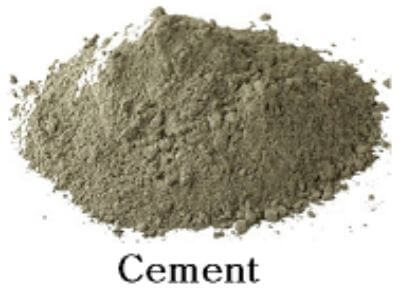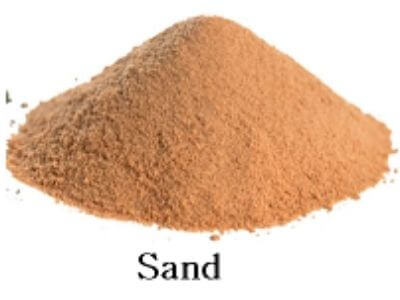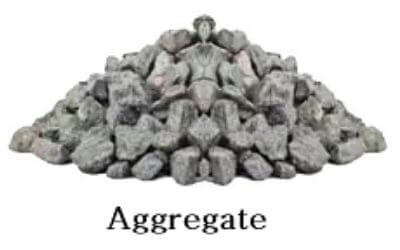Table of Contents
The density of Cement, Sand and Aggregate
Density, also known as the unit weight, is the mass per unit volume of the material. The symbol RHO (ρ) denotes it. It explains the degree of compactness of a material. If the density of any substance is high, that means it is denser.
Mass per unit volume of any construction material refers to its density. It is presented in Kg/m3 or lb/ft3 and shows the construction material’s compactness.
Density can be stated as ρ = m / v = 1/v
Where
ρ = Density
m = Mass
V = Volume
Density of Cement
A cement is a binding substance utilised in construction work that hardens and gains strength quickly underwater.

Only cement is unusually used; it is used to bind coarse and fine aggregate to produce mortar and concrete. The cement is mixed with fine aggregate to have mortar for plaster and masonry, and with sand and coarse aggregate to give concrete.
As I said, earlier density is the material’s mass per unit volume. Since we measure mass in kg or lb and volume in litre or cubic meter or cubic feet, hence density is stated in Kg/m3 or lb/ft3. The density of OPC cement is = 1440 Kg/m3.
Also Read – Difference Between OPC and PPC Cement
Sand Density
The density of sand varies according to its conditions ( Dry or Wet or packed).

The density of sand may change if it is in a dry or wet condition as well as a loose and compacted state. When sand is packed, sand particles are forced to form a narrow disposition, resulting in more material in the volume.
When sand is in wet conditions, water is present in sand particles that change material quantity in the volume. The average density of sand in a different state is as follows:
Loose Sand Density: 1442 Kg/m3
Dry Sand Density: 1602 Kg/m3
Packed Sand Density: 1682 Kg/m3
Packed Sand Density: 2082 Kg/m3
Also, Read – Silt Content Test for Sand
Density of Aggregate
Aggregates are chemically idle substances that are bonded by cement paste to make concrete. Aggregates produce the majority of the total concrete volume; hence, they affect concrete strength significantly.
Based on their size, the aggregates are named as:
- Fine Aggregate
- Coarse Aggregate
The material below 4.75 mm in size refers to fine aggregate. The percentage of all types of harmful matter in fine aggregate should not surpass 5%. Crushed stone dust or natural sand is the fine aggregate chiefly utilised in the concrete mix.
Sand may be collected from the river, sea, lake or pit. Still, when used in the concrete mix, it should be adequately cleaned and tested to determine that the total percentage of silt, salts, clay and other such organic stuff does not pass the defined limit.

The substance that particles are retained on IS sieve no 480 (4.75mm) refers to coarse aggregate. The Nature of the work decides which size of coarse aggregate should be used.
The maximum size maybe 20 cm for mass concrete, such as in dams etc. and 63 mm for plain cement concrete work.
For reinforced cement concrete work usually, 20 mm size aggregate is preferred. For structural concrete common materials like gravel and crushed stone are used.
Also, Read – What is M Sand? Properties, advantages, Disadvantages.
Bulk density of Aggregate
It is the weight of aggregate needed to fill a unit volume of the container. It helps to convert quantities by weight to by volume. It also indicates the aggregate grading and shape.
Bulk Density = Weight of aggregate / Container of unit volume
Unit: Kg/m3 or lb/ft3
Essential Points
- Bulk density is equal to mass if the volume is unit.
- In the above definition, the volume contains both aggregates along with voids between aggregate particles.
- The approximate value of bulk density for aggregate usually used for normal-weight concrete varies between 1200-1750 Kg/m3 or 75 to 110 lb/ft3.
Relative Density or Specific Gravity of Aggregate
Aggregate Contains both permeable and impermeable pores. The specific gravity of aggregate excluding all pores is referred to as the absolute specific gravity. It is described as
Absolute Specific Gravity = (Weight of oven-dried aggregate at 100°c for 24 hours) / (Weight of water’s volume equal to that of aggregate’s solids excluding pores)

Essential Points
- Most of the aggregates possess a relative density within 2.4 – 2.9 with a similar particle density of about 2400-2900 Kg/m3 (150-181 lb/ft3).
- Hereabouts, for coarse aggregates, the standard test process has been described in ASTM C 127(AASHTO), and for fine aggregates, the standard test practice has been described in ASTM C 128 (AASHTO).
- An aggregate relative density can be decided based on over dry or saturated surface dry.
The absolute specific gravity is usually not needed in concrete technology. If only permeable pores are considered, and the material’s solid volume is excluded, then the resulting specific gravity refers to apparent specific gravity. It is represented as
Apparent specific gravity = (Weight of oven-dried Aggregate at 100°c for 24 hours) / (Weight of water’s volume equal to that of aggregate’s solids excluding permeable pores)

In concrete technology, specific gravity based on a saturated surface dry condition is generally used. It is referred to as gross apparent specific gravity and is represented as
Gross apparent specific gravity = (Weight of dried aggregate in saturated surface dry condition) / (weight of water’s volume equal to that of aggregate, including all pores)

Density of Building Materials As Per IS 875 Part-1
Conversion:
1 KN/m3 = 101.9716 kg/m3 say = 100 kg/m3 (round off)
1 Kg/m3 = 0.0624 lb/ft3
| Construction Materials | Density in Kg/m3 | Density in KN/m3 | Density in lb/ft3 |
|---|---|---|---|
| Bitumen | 1040 | 10.4 | 64.896 |
| Brick Dust (Surkhi) | 1010 | 10.1 | 63.024 |
| Cement Mortar | 2080 | 20.8 | 129.792 |
| Chalk | 2100 | 21 | 131.04 |
| Clay Soil | 1900 | 19 | 118.56 |
| Earth (Dry) | 1410-1840 | 14.1-18.4 | 87.98-114.82 |
| Earth (Moist) | 1600-2000 | 16-20 | 99.84-124.8 |
| Fire Bricks | 2400 | 24 | 149.76 |
| Glass | 2500 | 25 | 156 |
| Granite Stone | 2400-2690 | 24-26.9 | 149.76-167.85 |
| Gypsum Mortar | 1200 | 12 | 74.88 |
| Gypsum Powder | 1410-1760 | 14.1-17.6 | 87.98-109.82 |
| Ice | 920 | 9.2 | 57.408 |
| Lime Mortar | 1600-1840 | 16-18 | 99.84-114.82 |
| Ordinary Cement | 1440 | 14.4 | 89.856 |
| PCC (Plain Cement Concrete) | 2400 | 24 | 149.76 |
| Pitch | 1010 | 10.1 | 63.024 |
| Prestressed Cement Concrete | 2400 | 24 | 149.76 |
| Rapid Hardening Cement | 1280 | 12.8 | 79.872 |
| RCC (Reinforced Cement Concrete) | 2500 | 25 | 156 |
| RCC Blocks | 2100 | 21 | 131.04 |
| Red Bricks | 1920 | 19.2 | 119.808 |
| Road Tar | 1010 | 10.1 | 63.024 |
| Rubber | 1300 | 13 | 81.12 |
| Sal Wood | 865 | 8.65 | 53.976 |
| Saline Water | 1025 | 10.25 | 63.96 |
| Sand (Dry) | 1540-1600 | 15.4 -16 | 96.09 – 99.84 |
| Sand (Wet) | 1760-2000 | 17.6 – 20 | 109.82 -124.8 |
| Sissoo Wood | 785 | 7.85 | 48.984 |
| Steel (Mild) | 7850 | 78.5 | 489.84 |
| Stone Ballast | 1720 | 17.2 | 107.328 |
| Stone chips | 1600 -1920 | 16 -19.2 | 99.84 -119.81 |
| Stainless Steel | 7480 | 74.8 | 466.752 |
| Teak Wood | 640 | 6.4 | 39.936 |
| Water | 1000 | 10 | 62.4 |
There are several materials used in building construction work. In the above table, we have tried to cover the density/unit weight of generally used building materials. I hope it helps you.
Thanks!
Also, Read
Unit Weight of Building Materials Used in Construction
Difference Between Pre Tensioning and Post Tensioning
Water Cement Ratio – Definition, Importance, Calculation
What is curing of Concrete? – Purpose, Importance, Curing Period & Method
What is Plinth Beam? – Plinth Protection, Difference Between Plinth Beam and Tie Beam
Building Estimate In Excel – Importance, Preparation